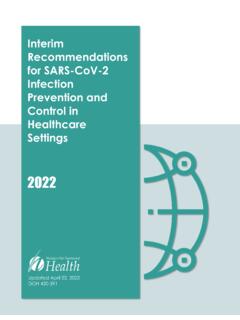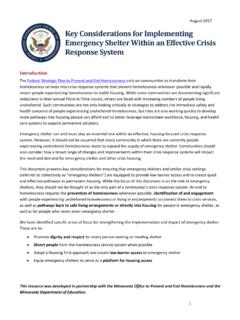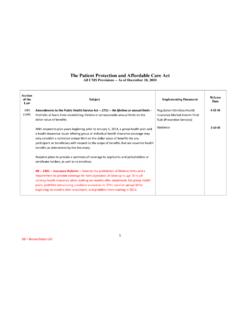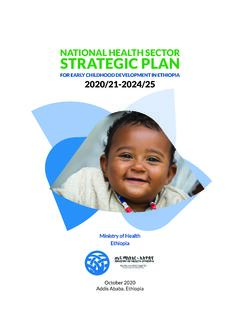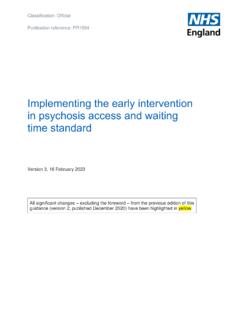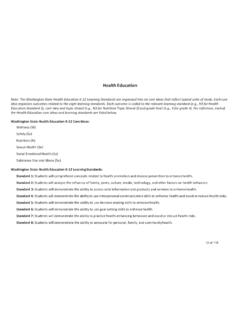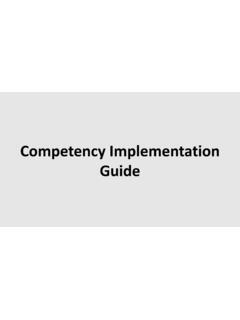Transcription of Screening programmes: a short guide - WHO | World Health ...
1 Increase effectiveness, maximize benefits and minimize harmScreening programmes: a short guideScreening programmes: a short guideIncrease effectiveness, maximize benefits and minimize harmAbstractThe purpose of Screening is to identify people in an apparently healthy population who are at higher risk of a Health problem or a condition, so that an early treatment or inter-vention can be offered and thereby reduce the incidence and/or mortality of the Health problem or condition within the population. There appears to be a growing trend in the WHO European Region towards more Screening for noncommunicable diseases and Health checks. However, in too many cases, a clear evidence base for effectiveness is missing. Policy-makers, Health professionals and the public often seem unaware of the potential harm of Screening , its cost and burden on the Health system and the need for strong quality assurance.
2 This guide is designed for policy-makers and public Health leads involved in planning, designing and implementing Screening programmes in the WHO European Region. It describes various aspects policy-makers should consider before starting, continuing or stopping a Screening programme and the operational, monitoring and evaluation aspects of implementation. This guide forms part of WHO s efforts to increase the effectiveness of Screening programmes within the Region, maxi-mizing benefits and minimizing harm. World Health Organization 2020 ISBN 978 92 890 5478 2 Some rights reserved. This work is available under the Creative Commons Attribution-NonCommercial-ShareAlike IGO licence (CC BY-NC-SA IGO; ). Under the terms of this licence, you may copy, redistribute and adapt the work for non-commercial purposes, provided the work is appropriately cited, as indicated below.
3 In any use of this work, there should be no suggestion that WHO endorses any specific organization, products or services. The use of the WHO logo is not permitted. If you adapt the work, then you must license your work under the same or equivalent Creative Commons licence. If you create a translation of this work, you should add the following disclaimer along with the suggested citation: This translation was not created by the World Health Organization (WHO). WHO is not responsible for the content or accuracy of this translation. The original English edition shall be the binding and authentic edition . Any mediation relating to disputes arising under the licence shall be conducted in accordance with the mediation rules of the World Intellectual Property citation.
4 Screening programmes: a short guide . Increase effectiveness, maximize benefits and minimize harm. Copenhagen: WHO Regional Office for Europe; 2020. Licence: CC BY-NC-SA (CIP) data. CIP data are available at , rights and licensing. To purchase WHO publications, see To submit requests for commercial use and queries on rights and licensing, see Third-party materials. If you wish to reuse material from this work that is attributed to a third party, such as tables, figures or images, it is your responsibility to determine whether permission is needed for that reuse and to obtain permission from the copyright holder. The risk of claims resulting from infringement of any third-party-owned component in the work rests solely with the disclaimers.
5 The designations employed and the presentation of the material in this publication do not imply the expression of any opinion whatsoever on the part of WHO concerning the legal status of any country, territory, city or area or of its authorities, or concerning the delimitation of its frontiers or boundaries. Dotted and dashed lines on maps represent approximate border lines for which there may not yet be full mention of specific companies or of certain manufacturers products does not imply that they are endorsed or recom-mended by WHO in preference to others of a similar nature that are not mentioned. Errors and omissions excepted, the names of proprietary products are distinguished by initial capital reasonable precautions have been taken by WHO to verify the information contained in this publication.
6 However, the published material is being distributed without warranty of any kind, either expressed or implied. The responsibility for the interpretation and use of the material lies with the reader. In no event shall WHO be liable for damages arising from its use. Address requests about publications of the WHO Regional Office for Europe to:PublicationsWHO Regional Office for EuropeUN City, Marmorvej 51DK-2100 Copenhagen , DenmarkAlternatively, complete an online request form for documentation, Health information, or for permission to quote or translate, on the Regional Office website ( ).iii ContentsList of boxes ivList of figures ivAcknowledgements viForeword viiPreface viiiIntroduction 1 What is Screening ? 3 Aims of Screening programmes 5 Wilson & Jungner s principles of Screening 7 Screening programmes as pathways 8 Measuring test performance 9 Understanding how Screening tests work in practice 9 Measuring outcomes from Screening programmes 12 Benefits and harm of Screening 14 Benefits 14 Maximizing the benefits of Screening programmes 14 Harm 14 Understanding harm 15 Balancing benefits and harm 18 How are benefits and harm compared?
7 18 Who benefits? 19 Does the context affect the balance between harm and benefits? 19 Ethics of Screening 19 Deciding whether to start or stop a Screening programme 22 Leading the process 22 Recognizing different interests 22Is Screening the answer? 22 What does the evidence say? 22 Modelling numbers and costs 25 Using criteria to guide decision-making 25 Pilot testing 27 Designing effective Screening programmes 28 Types of Screening 28 Multiple Screening tests carried out at the same time 28 Operational readiness 33 Leadership, coordination and management 33 Constructing a pathway 33 Trained personnel 33 Information systems 34 Funding 34 Health system capacity 37 Information and communication 37 Operating a Screening programme 39 Ensuring that Screening programmes deliver the anticipated benefits 39 Quality assurance systems 39 Improving participation 42 Monitoring and evaluation 44 Measures of Screening programme performance 45 Conclusion 48 References 49 Annex 1.
8 Explanation of technical terms used in the guide 53 Annex 2. Resources 57iv List of boxesBox 1. Wilson & Jungner s principles of Screening 7 Box 2. Reasons for overdiagnosis 16 Box 3. Occupational Health checks 20 Box 4. School-based Screening 21 Box 5. Decision pathway for Screening in Sweden 25 Box 6. Piloting breast cancer Screening in Belarus 27 Box 7. Informed consent in antenatal Screening 38 Box 8. Newborn Screening in Germany 40 Box 9. Albania: low uptake in cervical Screening has led to rethinking design and delivery 43 List of figuresFig. 1. Screening as a sieve 3 Fig. 2. Distinguishing Screening from early diagnosis in cancer according to symptom onset 4 Fig. 3. Aims of Screening programmes 5 Fig.
9 4. Steps in a simplified Screening pathway 8 Fig. 5. Measuring the performance of Screening tests 10 Fig. 6. How prevalence affects the positive predictive value 11 Fig. 7. Possible outcomes from a Screening programme 13 Fig. 8. Balancing benefits and harm 18 Fig. 9. Steps in deciding whether to start or stop a Screening programme 23 Fig. 10. Situational checklist 24 Fig. 11. Using evidence to develop recommendations for Screening policy 24 Fig. 12. Decision pathway for Screening in Sweden 26 Fig. 13. Screening pathway for a Screening programme for newborn hearing in the United Kingdom 35 Fig. 14. Examples of information leaflets for Screening tests 36 Fig. 15. Use of infographic to illustrate overdiagnosis in breast cancer Screening 38 Fig.
10 16. Lead-time bias 46 Fig. 17. Comparison of change in incidence and mortality rates for thyroid cancer in Italy 47v WHOvi AcknowledgementsThis guide is an output of an initiative of the WHO Regional Office for Europe, strategically coordinated by Jill Farrington, WHO Regional Office for Europe, that aims to improve Screening practice through the life-course to increase effective-ness, maximize benefits and minimize Cohen, WHO consultant, wrote this guide with the support of Jill Farrington, Marilys Corbex and Mar a Lasierra Losada, WHO Regional Office for Europe. This guide draws on the background papers written by John Brodersen and Frederik Martiny, University of Copenhagen, commissioned by WHO for the 2019 WHO European Technical Consultation on received from peer reviewers Kristoffer Lande Andersen, Christine Berling, Aleksandar Bojovic, Fr d ric de Bels, Amiran Gamkrelidze, Fran oise Hamers, Marlene hrberg Krag, Nana Mebonia, Petra Uschold, Martin Weber and Elena Yurasova are much appreciated.










